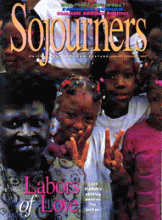For the first time in memory, the Latino community took to the streets of Washington, D.C., in large numbers on October 12, 1996. (The date carries much significance in that the dominant culture of North America celebrates it as "Columbus Day." Most others in this hemisphere call it by other names—chief among them, "Indigenous Peoples Day.") To march with the thousands of Spanish-speaking brothers and sisters that day was to marvel at the many enriching aspects of this community in our midst.
First and most obvious is their youthfulness and vigor. Moving down Washington's lovely 16th Street toward Lafayette Square and the White House, one was carried along by wave after wave of enthusiastic Latino kids. Upon reflection, this phenomenon comes as no surprise. The major part of the population in just about every country from Mexico on south is under 15 years of age. That demographic fact raises interesting questions for our aging U.S. society as the next few decades unfold.
The sheer numbers of Latinos that day made a deep impression as well. Washington, D.C. police have all but given up attempts to calculate crowd size, given past difficulties and controversies around such estimates. I am left with impressions. For example, walking downhill somewhere in the middle of the throng, I looked ahead over a sea of humanity and could not see the lead marchers; looking behind me, it was the same—no end in sight. The Latinos were out in force.
Gratifying qualities of the Latino community penetrated my consciousness as we walked along. The Spanish language, whether understood or not, sounds musical, upbeat, and embracing when it surrounds you. The question pops into mind: Why would anyone want a law to prohibit such a lovely means of expression in multicultural United States?
Read the Full Article
